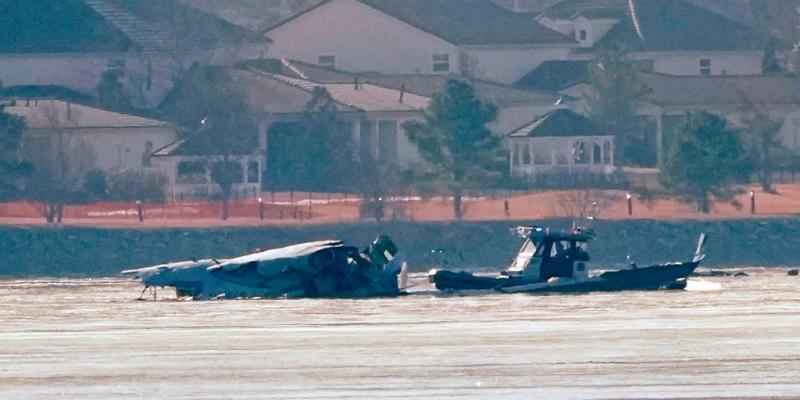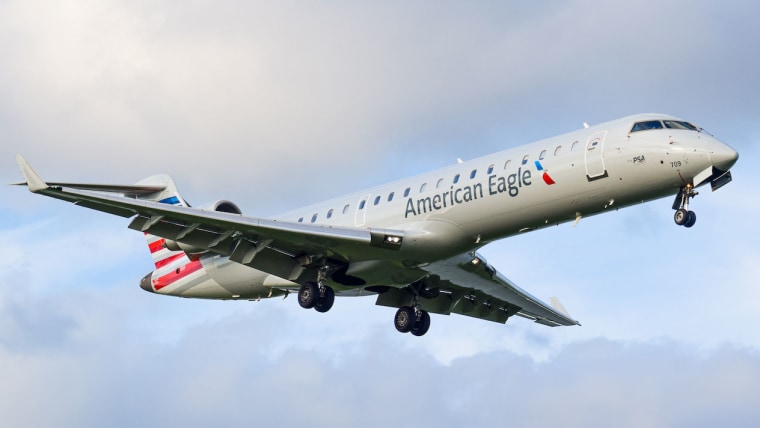What caused the deadly D.C. plane crash between an American Airlines jet and Army Black Hawk helicopter?
Category: News & Politics
Via: perrie-halpern • 3 months ago • 9 commentsBy: Elizabeth Chuck, Jon Schuppe and Melissa Chan



By Elizabeth Chuck, Jon Schuppe and Melissa Chan
The skies on Wednesday night were clear. The pilots were in communication with air traffic control, and officials said American Eagle Flight 5342 was on a standard descent to the runway in the busy airspace above the nation's capital. Yet somehow, the passenger jet and an Army helicopter collided midair, bursting into flames and plunging into the Potomac River in the first major fatal commercial plane crash in the United States in 16 years.
Federal investigators are now searching for answers in what is expected to be a lengthy process. A number of factors, both technological and human-driven, could have played a role in the deadly accident, aviation experts say, including whether multilayered systems designed to stop collisions functioned properly.
"Everything, unfortunately, lined up for this accident to happen," said Kenneth Byrnes, a pilot and chairman of the flight training department at Embry‑Riddle Aeronautical University.
The National Transportation Safety Board is leading the investigation, which will also involve the Federal Aviation Administration and the Army. The painstaking process will include the collection of evidence from the scene, reviews of radio traffic and data on aircraft flight paths, communications with air traffic controllers and interviews with those controllers. Such investigations can take a year or longer to reach a conclusion, and the NTSB is the only agency authorized to provide an official cause for the crash.
"We look at the human, the machine and the environment," NTSB Chair Jennifer Homendy told reporters Thursday. "We will look at all the humans that were involved in this accident. We will look at the aircraft. We will look at the helicopter. We will look at the environment in which they were operating in. That is standard."
Officials cautioned that it is still too early to speculate about what led to the crash that killed all 64 on board the American Eagle jet and all three crew members on the Army Black Hawk helicopter.
Aviation experts say that the focus for investigators will likely be on several elements, including an automated system that should have warned the plane's pilot that another aircraft was close by; the pilots' communications with air traffic controllers; and any visual obstructions that could have prevented the pilots from seeing each other. They will also investigate any missteps by the pilots, though two aviation experts told NBC News that there was nothing pointing in that direction.
The disaster — the first major fatal commercial plane crash in the United States since 2009 — happened just before 9 p.m. ET Wednesday as the American Eagle jet, a regional aircraft owned by American Airlines, was descending into Ronald Reagan Washington National Airport, where airline pilots routinely navigate tight and crowded airspace.
While commercial jets have a safety system called the Traffic Alert and Collision Avoidance System, or TCAS, that gives pilots verbal cues when they are in danger of colliding with another aircraft, most military helicopters are not equipped with the same technology, said Jimmie Cummings, a spokesperson for the Army Combat Readiness Center. He said the chopper in the crash did not have it.
Regardless, there are limitations to TCAS. One is that the system reduces the number of alerts it issues as a plane descends in order to avoid false alarms from other aircraft on the ground. The American Eagle's last recorded altitude was at 375 feet, according tothe aircraft tracking websiteFlightAware.
John Halverson, a veteran pilot who said he has extensive experience landing at Reagan National airport, noted that FlightAware data appeared to show a by-the-book approach and descent. He added that pilots at that point in the landing process are focused on the runway and their instruments.
"They were in the slot. They were exactly where they needed to be," he said.
Communication between the aircraft and air traffic controllers also was routine. Transportation Secretary Sean Duffy told reporters that both the passenger jet and the helicopter had experienced pilots and "standard communication" with the air traffic control tower when they crashed.
"Everything was standard in the lead-up to the crash," he said. "Obviously something happened here."
According to a preliminary FAA safety report on the collision, at the time of the crash, one controller at the tower was focused on both helicopters and airplanes, a source with knowledge of the situation told NBC News. Usually, the tower has a separate controller who deals exclusively with choppers. FAA guidelines allow for the combined position.
Jeff Guzzetti, a former accident investigator for the FAA and the NTSB, said any dialogue with air traffic control will be a primary focus of the investigation.
"You can be sure that the air traffic control communications are going to be scrutinized by the NTSB, that controller is going to be interviewed, and the radar data is going to be looked at by NTSB," he told the "TODAY" show on Thursday. "There's going to be a lot of human factors involved."
Though officials stress that air travel has never been safer in America, Wednesday's accident has raised concerns, particularly in high-traffic areas like the nation's capital. Reagan National airport presents unique challenges — limits on where commercial flights are allowed to fly, skies congested with military aircraft and plenty of light on the ground, said Shawn Pruchnicki, a former airline pilot and an assistant professor at the Center for Aviation Studies at the Ohio State University.
"Reagan is just so saturated with lights. It's very easy to lose sight of an airplane in that flood of lights," he said.
The aviation experts said there is also a possibility that the aircraft were in each other's blind spots — which planes and helicopters have, just like cars. The fact that the two aircraft were so close to the ground would have meant they had limited time to maneuver around blind spots.
"Helicopter pilots can't be just constantly leaning forward or backward, because you could become disoriented," Pruchnicki said. "So there could have been a visual obstruction for them as they were trying to find this jet, and they ran out of time."
A report this month by the Army Combat Readiness Center found that in fiscal year 2024, the Army had the highest number of serious accidents, including fatalities, in a decade. Of the 15 incidents, only one involved a Black Hawk. The report noted that pilots might not be getting enough flight hours.
Jimmie Cummings, a spokesperson for the center, said it was difficult to explain the spike. He declined to comment on the flight-hours issue, however. "We're really not doing things differently. We do all we can to promote safety but, at the end of the day, what we do is dangerous," Cummings said.
 The American Eagle jet that was involved in a collision over the Potomac River on Wednesday night pictured in 2022 near Ronald Reagan Washington International Airport. David Liebowitz
The American Eagle jet that was involved in a collision over the Potomac River on Wednesday night pictured in 2022 near Ronald Reagan Washington International Airport. David Liebowitz
The American Eagle jet, which was carrying 60 passengers and four crew members from Wichita, Kansas, was on a normal approach to Reagan, officials said. The chopper, an Army Black Hawk with three crew members from nearby Fort Belvoir, Virginia, was conducting a training flight — a common practice in the busy airspace above Reagan.
"This was not unusual with a military aircraft flying over the river and aircraft landing at DCA," Duffy said, referring to the airport. "If you live in the area, you'll see that frequently with those two aircraft working together."
Dean Winslow, a retired Air Force colonel and onboard physician, said Black Hawks "are not incredibly maneuverable" and would have difficulty avoiding an airliner. "It would have been very difficult to see and avoid," Winslow said.
The Army pilots aboard the helicopter had night vision goggles, Defense Secretary Pete Hegseth said on X. Winslow said night goggles can help view terrain and obstacles, but also can restrict a pilot's field of view, "like looking through soda straws."
Radio traffic recordings indicate that one of the last communications that took place was a controller asking the helicopter pilot if they saw the plane, and directing the chopper to pass behind it.
Seconds later, the helicopter slammed into the plane, a fireball lighting up the sky.



It's not rocket science. The crash was caused by a military helicopter that had no good reason to be there. The military pilot wasn't there on a whim, either. The military commander that authorized and approved this flight plan needs to be given the boot.
As I understand it, this practice has been going on for a long time. Perhaps it's time to alter the procedure. And then we see a similar situation just a day prior to the accident. You have to wonder how many "near hits" have occurred over time.
Potomac Mid Air UPDATE 1/30/25
TCAS Avoided Collision with Army Helicopter Over Potomac River
The chopper was supposed to have a 200ft hard deck. My money is on it was flying higher than that.
The LIKELY PROBABILITY OF SUCH AN ACCIDENT is directly CONNECTED TO DECISIONS EARIER IN THE WEEK BY THE WHITE HOUSE TO gut the key aviation safety advisory committee, leaving it without members once tasked with examining safety issues at airlines and airports & Elon Musk fired an FAA administrator to avoid his SPACEX violation resulting in a $283,009 penalty. The company was given 30 days to appeal the fines, which totalled $633,009
Lol. Please, please try and prove that connection.
Why should I? I said he MAY be the real reason, which is obviously speculation on my part. Why don't you go ahead and prove that he WASN'T the real reason? You won't because you don't have to, nor will I because I don't have to.
You said it was a likely probability that it was directly connected to the accident. I assumed you had some rational basis to make that claim other than the generic "it's not impossible."
[deleted][✘]
You cannot show what Trump said is true. So you just harp on some level of hiring purity that you want adhered to.
If candidates for president were subjected to competency tests Trump would get an F. But he was hired anyway.
Trump sort of implied yesterday that mentally disable people are being trained as air traffic controllers, do you have any evidence of that, or are mentally disabled people being hired to empty waste baskets and mop floors and get coffee in the FAA office. .
Trump is a piece of shit and you guys enable him every single day.
This dangerous mix of military and commercial aviation was a well-established practice long before Trump arrived on the scene.
Trump is shaking up every department of government and the FAA is a fuked up mess. Many towers and centers are understaffed all across the country. Trump will see that it gets fixed by putting competent people in critical spots.
As usual, the left wingers have no answers and can only blame and bitch. No wonder the electorate totally rejected the progressives.
I like what Trump is doing and the picks he's making, so I guess I am an enabler.